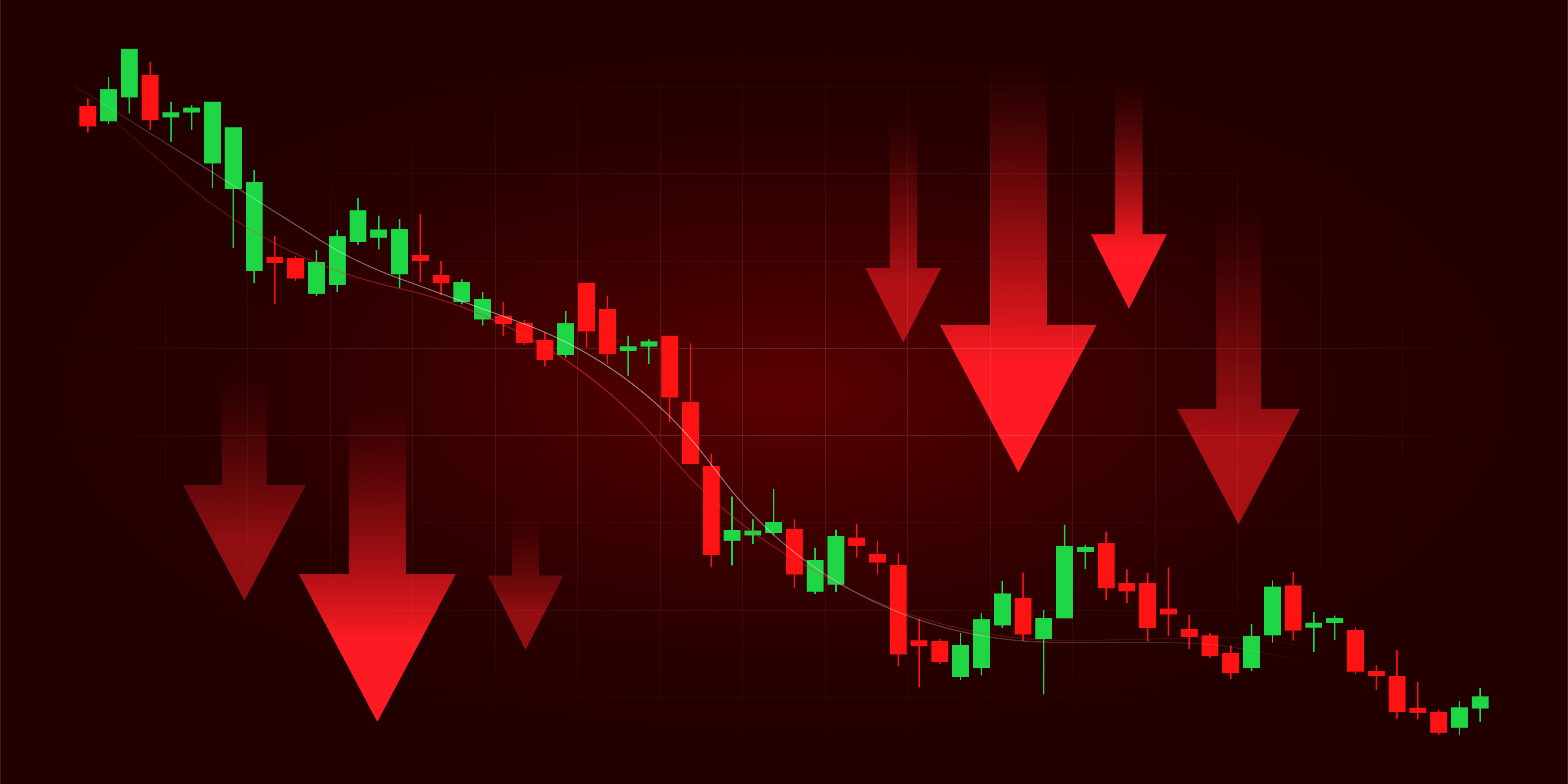Dow Sinks 301 Points on Trade War Talk: Stock Market Today
The contentious relationship between the world's two biggest economies continues to drive global financial markets.


Stocks were up early and down late again during another volatile session defined by trade war talk. Incoming economic data remains limited and mixed. But earnings results and forward guidance offer continuing comfort. Still, recent price action is as much about fear of conflict between the U.S. and China as fundamentals.
"We're in one now," President Donald Trump said late Wednesday when a reporter asked whether recent escalation meant the U.S. is headed for a "sustained trade war" with China.
President Trump is scheduled to meet President Xi Jinping in South Korea at the end of the month. "We have a 100% tariff," said Trump, underscoring his most recent threatened rate. "If we didn't have tariffs, we would be exposed as being a nothing."
From just $107.88 $24.99 for Kiplinger Personal Finance
Become a smarter, better informed investor. Subscribe from just $107.88 $24.99, plus get up to 4 Special Issues

Sign up for Kiplinger’s Free Newsletters
Profit and prosper with the best of expert advice on investing, taxes, retirement, personal finance and more - straight to your e-mail.
Profit and prosper with the best of expert advice - straight to your e-mail.
"While the latest U.S.-China trade flareup has dominated recent market headlines," observes Daniel Skelly, head of Wealth Management Market Research & Strategy at Morgan Stanley, "the story remains the same for stock investors – the importance of focusing on large-cap, quality companies."
Skelly notes the Russell 2000 Index of small-cap stocks is up more than 16% vs a gain of less than 7% for the S&P 500 since early August, but says there may be limited room left for the "everything rally" to run.
"While there's no recession on the horizon," he concludes, "a cooling labor market and slowing economic growth could pose a challenge for many of the lower-quality, unprofitable companies that hitched a ride on the rally off the April lows."
The Cboe Volatility Index (VIX) saw another intraday surge, rising as high as 25.43 from 20.64 as of Wednesday's close before settling at 24.96. The VIX has risen from 16.43 on October 9. A "normal" range for what's widely recognized as the market's "fear index" is between 12 and 20.
At Thursday's closing bell, the blue chip Dow Jones Industrial Average was down 0.7% at 45,952, the broad-based S&P 500 had shed 0.6% to 6,629, and the tech-heavy Nasdaq Composite was off 0.5% at 22,562.
This is the data we have
While the government shutdown prevented the release of weekly jobless claims, Producer Price Index (PPI) and retail sales numbers, the Federal Reserve Bank of Philadelphia did produce its Manufacturing Business Outlook Survey for October.
The Philadelphia Fed manufacturing index dropped to -12.8 in October from +23.2 in September and came up well short of a median forecast of +10.0. "The composition was mixed to weak," writes Goldman Sachs Chief Economist Jan Hatzius, "as the new orders component increased while the shipments and employment components declined."
Meanwhile, the NAHB Housing Market Index printed at 37 in October, up from 32 in September and surprising a consensus that saw no change coming. Still, as Wells Fargo economists Jackie Benson and Ali Hajibeigi note, the index is well below its 2015-19 average of 64. "Builders remain fairly pessimistic overall," they conclude, "making it unlikely that residential construction will materially improve in the near term."
The force is strong again
Salesforce (CRM, +4.0%) was No. 1 among Dow Jones stocks on Thursday after the software maker announced a new long-term revenue target of $60 billion by fiscal year 2030. The updated guidance excludes the pending Informatica (INFA, -0.1%) acquisition, and it implies a compound annual growth rate of more than 10% from fiscal 2026 through fiscal 2030.
"We're leading the next great transformation in business – the era of the Agentic Enterprise – where AI elevates human potential and accelerates growth," said Salesforce CEO Marc Benioff in a statement.
CFO Robin Washington said the company's Agentforce AI platform "was built for this moment," citing more than $10 billion in R&D spending since fiscal 2024. "Seeing this innovation translate into real customer success," Washington said, "directly fuels our confidence in delivering sustained double-digit growth and achieving our long-term profitability targets."
Keep on truckin'
J.B. Hunt Transport Services (JBHT, +22.1%) rallied after management reported third-quarter earnings of $1.76 per share, up from $1.49 a year ago and better than Wall Street's $1.46 forecast. The industrial stock narrowed its year-to-date loss to a less than 1%.
Operating revenue was basically flat at $3.05 billion vs. $3.07 billion a year ago but was slightly ahead of consensus expectations for $3.0 billion. As Stifel analyst Bruce Chan notes, the Intermodal and Dedicated segments drove results, with management's cost-cutting and efficiency efforts supporting margin improvement and earnings growth despite a flat top line.
Volume growth may be constrained by macro demand and tariff uncertainty in the medium term, Chan explains. "The company is an industry leader, but we are valuation-sensitive and remain Hold-rated." The analyst did raise his 12-month target price for JBHT from $140 to $147.
Big moves for a small biopharma stock
Praxis Precision Medicines (PRAX, +183.7%) was up as much as 259% at its intraday peak after management announced positive results for its experimental drug to treat a type of movement disorder. The clinical-stage biopharmaceutical stock saw its market cap surge from $1.21 billion at Wednesday's closing bell to $3.67 billion.
According to Praxis, two late-stage trials among adult patients with essential tremor showed its Ulixacaltamide therapy improved their ability to perform daily tasks. "Essential tremor" is a nervous system condition that causes involuntary shaking in the hands and arms and has no specific treatment yet.
In February, an independent data monitoring committee overseeing the study recommended it "be stopped for futility, due to the results being unlikely to meet the primary efficacy endpoint under the parameters set by the statistical model."
Related content
- Earnings Calendar and Analysis for This Week (October 13-17)
- Best SPDR ETFs to Buy and Hold
- How to Invest for Fall Rate Cuts by the Fed
Profit and prosper with the best of Kiplinger's advice on investing, taxes, retirement, personal finance and much more. Delivered daily. Enter your email in the box and click Sign Me Up.

David Dittman is the former managing editor and chief investment strategist of Utility Forecaster, which was named one of "10 investment newsletters to read besides Buffett's" in 2015. A graduate of the University of California, San Diego, and the Villanova University School of Law, and a former stockbroker, David has been working in financial media for more than 20 years.
-
 I'm want to give my 3 grandkids $5K each for Christmas.
I'm want to give my 3 grandkids $5K each for Christmas.You're comfortably retired and want to give your grandkids a big Christmas check, but their parents are worried they might spend it all. We ask the pros for help.
-
 If You're Not Doing Roth Conversions, You Need to Read This
If You're Not Doing Roth Conversions, You Need to Read ThisRoth conversions and other Roth strategies can be complex, but don't dismiss these tax planning tools outright. They could really work for you and your heirs.
-
 Could Traditional Retirement Expectations Be Killing Us?
Could Traditional Retirement Expectations Be Killing Us?A retirement psychologist makes the case: A fulfilling retirement begins with a blueprint for living, rather than simply the accumulation of a large nest egg.
-
 I'm a Financial Planner: If You're Not Doing Roth Conversions, You Need to Read This
I'm a Financial Planner: If You're Not Doing Roth Conversions, You Need to Read ThisRoth conversions and other Roth strategies can be complex, but don't dismiss these tax planning tools outright. They could really work for you and your heirs.
-
 Could Traditional Retirement Expectations Be Killing Us? A Retirement Psychologist Makes the Case
Could Traditional Retirement Expectations Be Killing Us? A Retirement Psychologist Makes the CaseA retirement psychologist makes the case: A fulfilling retirement begins with a blueprint for living, rather than simply the accumulation of a large nest egg.
-
 I'm a Financial Adviser: This Is How You Can Adapt to Social Security Uncertainty
I'm a Financial Adviser: This Is How You Can Adapt to Social Security UncertaintyRather than letting the unknowns make you anxious, focus on building a flexible income strategy that can adapt to possible future Social Security changes.
-
 I'm a Financial Planner for Millionaires: Here's How to Give Your Kids Cash Gifts Without Triggering IRS Paperwork
I'm a Financial Planner for Millionaires: Here's How to Give Your Kids Cash Gifts Without Triggering IRS PaperworkMost people can gift large sums without paying tax or filing a return, especially by structuring gifts across two tax years or splitting gifts with a spouse.
-
 'Boomer Candy' Investments Might Seem Sweet, But They Can Have a Sour Aftertaste
'Boomer Candy' Investments Might Seem Sweet, But They Can Have a Sour AftertasteProducts such as index annuities, structured notes and buffered ETFs might seem appealing, but sometimes they can rob you of flexibility and trap your capital.
-
 AI Stocks Lead Nasdaq's 398-Point Nosedive: Stock Market Today
AI Stocks Lead Nasdaq's 398-Point Nosedive: Stock Market TodayThe major stock market indexes do not yet reflect the bullish tendencies of sector rotation and broadening participation.
-
 Got $100 to Gamble? These Penny Stocks Could Be Worth the Ride
Got $100 to Gamble? These Penny Stocks Could Be Worth the RideVolatile penny stocks are high-risk plays with potentially high rewards. If you have $100 you can afford to lose, these three names are worth a look.
-
 Quick Question: Are You Planning for a 20-Year Retirement or a 30-Year Retirement?
Quick Question: Are You Planning for a 20-Year Retirement or a 30-Year Retirement?You probably should be planning for a much longer retirement than you are. To avoid running out of retirement savings, you really need to make a plan.